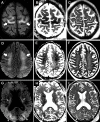COVID-19-associated Diffuse Leukoencephalopathy and Microhemorrhages
- PMID: 32437314
- PMCID: PMC7507998
- DOI: 10.1148/radiol.2020202040
COVID-19-associated Diffuse Leukoencephalopathy and Microhemorrhages
Abstract
Diffuse leukoencephalopathy and juxtacortical and/or callosal microhemorrhages were brain imaging features in critically ill patients with coronavirus disease 2019. Coronavirus disease 2019 (COVID-19) has been reported in association with a variety of brain imaging findings such as ischemic infarct, hemorrhage, and acute hemorrhagic necrotizing encephalopathy. Herein, the authors report brain imaging features in 11 critically ill patients with COVID-19 with persistently diminished mental status who underwent MRI between April 5 and April 25, 2020. These imaging features include (a) confluent T2 hyperintensity and mild restricted diffusion in bilateral supratentorial deep and subcortical white matter (in 10 of 11 patients) and (b) multiple punctate microhemorrhages in juxtacortical and callosal white matter (in seven of 11 patients). The authors also discuss potential pathogeneses.
© RSNA, 2020.
Figures





References
-
- Levi M, Toh CH, Thachil J, Watson HG. Guidelines for the diagnosis and management of disseminated intravascular coagulation. British Committee for Standards in Haematology. Br J Haematol 2009;145(1):24–33. - PubMed
MeSH terms
LinkOut - more resources
Full Text Sources
Miscellaneous

